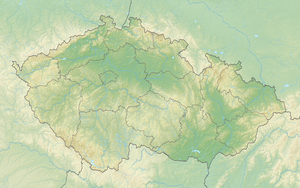Švihov Castle
| Švihov Castle | ||
|---|---|---|
| Creation time : | 14th century | |
| Conservation status: | ruin | |
| Place: | Švihov | |
| Geographical location | 49 ° 28 '43.6 " N , 13 ° 17' 5.6" E | |
|
|
||
The castle Švihov (German Schwihau ) is located in Švihov in Okres Klatovy , in the Czech Republic . The complex was essentially rebuilt between 1480 and 1489; individual works dragged on until around 1520. In the 17th century the defenses had to be partially demolished. From 1952 the facility was restored and reconstructed and houses a museum.
history
The Schwihau manor , on the edge of the Pilsner Basin near the royal town of Klattau / Klatovy on an old trade route between Bohemia and Bavaria, was built in the first half of the 14th century as a moated castle on the Úhlava River .
At the beginning of the modern era it was one of the family castles of the Lords of Riesenberg . Botho (Puta) Schwihau von Riesenberg , Supreme Judge of the Kingdom of Bohemia, had this castle rebuilt between 1480 and 1489 (inscription in the chapel) and expanded it into the center of a profitable manorial rule in western Bohemia . After his death in 1504, the facility was divided between two of his sons and rebuilt accordingly. Individual works on the fortification may dragged on until around 1520 and were related to the royal architect Benedikt Ried .
In 1558 the castle came into the possession of the Counts of Czernin .
After the end of the Thirty Years War , the extensive fortifications were added to the list of fortresses in 1655, which Ferdinand III ordered. should be destroyed. Bastions and battlements were razed. After that, the castle was used as a granary in a poor condition. A renovation and partial reconstruction after 1952 helped to give an idea of the size and importance of the complex. The core of the castle is made up of two residential wings that were built between 1480 and 1489. In the east there is a simultaneous chapel between them, in the west a mighty gate tower dominates.
A portrait of Schwihau shows a wall painting from the legend of St. George in the castle chapel from the 16th century. A splendidly bridled horse is ridden against a dragon by a beautifully dressed knight who raises his sword for the final blow. This winds, already hit by a lance, at the horse's feet. A princess is kneeling on the right; A lamb lies at her side. The representation is probably influenced by the kite festival taking place at the same time in Furth im Wald .
The last owner of Schwihau until 1945, the end of the Second World War, was Eugen Graf Czernin von und zu Chudenitz , from a Bohemian nobility family from the Chudenice family castle in the immediate vicinity of Svihov.
The interiors house exhibits on the way of life in the 16th century (castle museum).
Exhibition on the film "Three Hazelnuts for Cinderella"
In 1972, the farm buildings in the outer bailey served as the backdrop for one of the most famous fairy tale films: Three hazelnuts for Cinderella . There is a small permanent exhibition on the film in the castle with original cloakrooms and film utensils, which is the counterpart to the large exhibition in Moritzburg Castle in Saxony . The castle is also used today for film productions.
literature
- Johanna von Herzogenberg : Between Danube and Moldau. Bavarian Forest and Bohemian Forest. The Mühlviertel and South Bohemia, Prestel Verlag Munich, 1968, page 106 f.
Web links
- Castle homepage (cz)
- Schwihau Castle on bayerischer-wald.de




